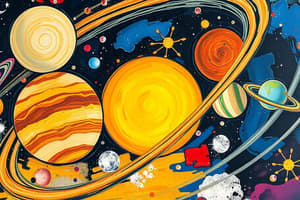Podcast
Questions and Answers
Скільки планет входить до складу нашої сонячної системи?
Скільки планет входить до складу нашої сонячної системи?
Яка планета є найменшою в Сонячній системі?
Яка планета є найменшою в Сонячній системі?
Яка планета є найближчою до Сонця?
Яка планета є найближчою до Сонця?
Яка планета обертається в протилежному напрямку, ніж інші планети?
Яка планета обертається в протилежному напрямку, ніж інші планети?
Signup and view all the answers
Яка планета в Сонячній системі має найбільший вулкан?
Яка планета в Сонячній системі має найбільший вулкан?
Signup and view all the answers
Яка планета має найбільшу кількість супутників?
Яка планета має найбільшу кількість супутників?
Signup and view all the answers
Яка планета у нашій Сонячній системі має найбільше відомих супутників?
Яка планета у нашій Сонячній системі має найбільше відомих супутників?
Signup and view all the answers
Яка планета має кільця, складені переважно з крижаних та скельних уламків?
Яка планета має кільця, складені переважно з крижаних та скельних уламків?
Signup and view all the answers
Яка планета була першою виявленою за допомогою телескопа?
Яка планета була першою виявленою за допомогою телескопа?
Signup and view all the answers
Яка планета знаходиться найдалі від Сонця?
Яка планета знаходиться найдалі від Сонця?
Signup and view all the answers
Яка планета має сильніші вітри у нашій Сонячній системі?
Яка планета має сильніші вітри у нашій Сонячній системі?
Signup and view all the answers
Яка планета має своєрідний колір через метан у її атмосфері?
Яка планета має своєрідний колір через метан у її атмосфері?
Signup and view all the answers
Study Notes
Earth is one of eight planets in our solar system, which includes Mercury, Venus, Mars, Jupiter, Saturn, Uranus, Neptune, and Pluto. Our planet plays a crucial role in sustaining life through its water resources, atmosphere, magnetic field, and radiation shielding capabilities. Earth's position within our solar system offers unique conditions for life, making it a significant focus for scientists studying habitable environments. Here are some key points about each planet in our solar system:
Mercury:
Mercury is the smallest planet and the closest to the sun, with an orbital period of just 88 days. Its surface is heavily cratered due to meteor impacts and has temperatures ranging from a high of 800 degrees Fahrenheit during the day to minus 170 degrees at night.
Venus:
Venus is similar in size to Earth but has a thick atmosphere composed mainly of carbon dioxide, nitrogen, and sulfuric acid. It's the brightest planet in our sky and is often visible before sunrise or after sunset. Venus rotates in the opposite direction of other planets, which means its Sun rises in the west and sets in the east.
Mars:
Mars, also known as the Red Planet, is about half the size of Earth and has a thin atmosphere consisting mostly of carbon dioxide with traces of nitrogen and argon. Water ice exists near both poles, while seasonally on the equatorial region. Mars is home to Olympus Mons, the largest volcano and highest mountain in the solar system.
Jupiter:
Jupiter is the largest planet in our solar system, composed mainly of hydrogen and helium. Its Great Red Spot is a storm that has been raging for at least 400 years, measuring more than twice the size of Earth. Jupiter has 79 known moons, including Io, Europa, Ganymede, and Callisto.
Saturn:
Saturn is famous for its ring system made primarily of chunks of ice and rock. It's the second-largest planet in our solar system and is known for its many moons, including Titan, which is larger than the planet Mercury. The six biggest moons discovered so far are called the "Cassini Division" or "Division Cassini," named after the Italian scientist who first observed them.
Uranus:
Uranus is the first planet discovered with a telescope. It's the third-largest planet in our solar system, with a blue-green color due to the presence of methane in its atmosphere. Uranus is tilted on its side, which may have been caused by a collision with another celestial body early in its history.
Neptune:
Neptune is the farthest known planet from the sun and is a deep blue color due to methane in its atmosphere. It's the fourth-largest planet in our solar system and is the first planet discovered through mathematical predictions rather than telescopic observations. Neptune has the strongest winds in the solar system, with speeds that can reach 2,100 kilometers per hour.
Pluto:
Pluto is a dwarf planet located in the Kuiper Belt, a region of icy bodies beyond Neptune. Its surface is covered in a mix of frozen nitrogen, methane, and carbon monoxide ices. Pluto has five known moons: Charon, Nix, Hydra, Kerberos, and Styx.
These planets each offer unique characteristics and conditions that contribute to the diverse nature of our solar system. Studying them helps us understand the universe better and our place within it.
Studying That Suits You
Use AI to generate personalized quizzes and flashcards to suit your learning preferences.
Description
Explore the key characteristics of the eight planets in our solar system, including details about their size, composition, atmosphere, moons, and unique features. From the closest planet to the sun, Mercury, to the distant dwarf planet Pluto, each celestial body offers valuable insights into the diversity of our solar system.



